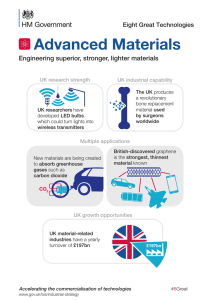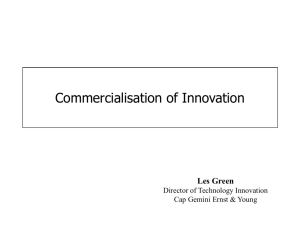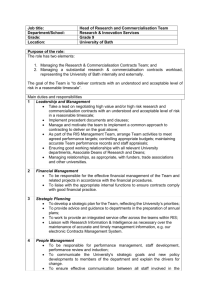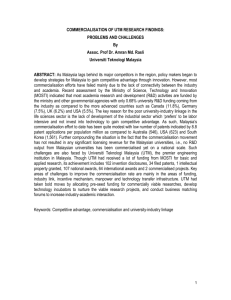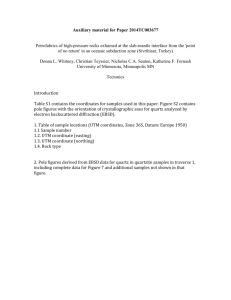University Research, Development & Commercialisation
advertisement
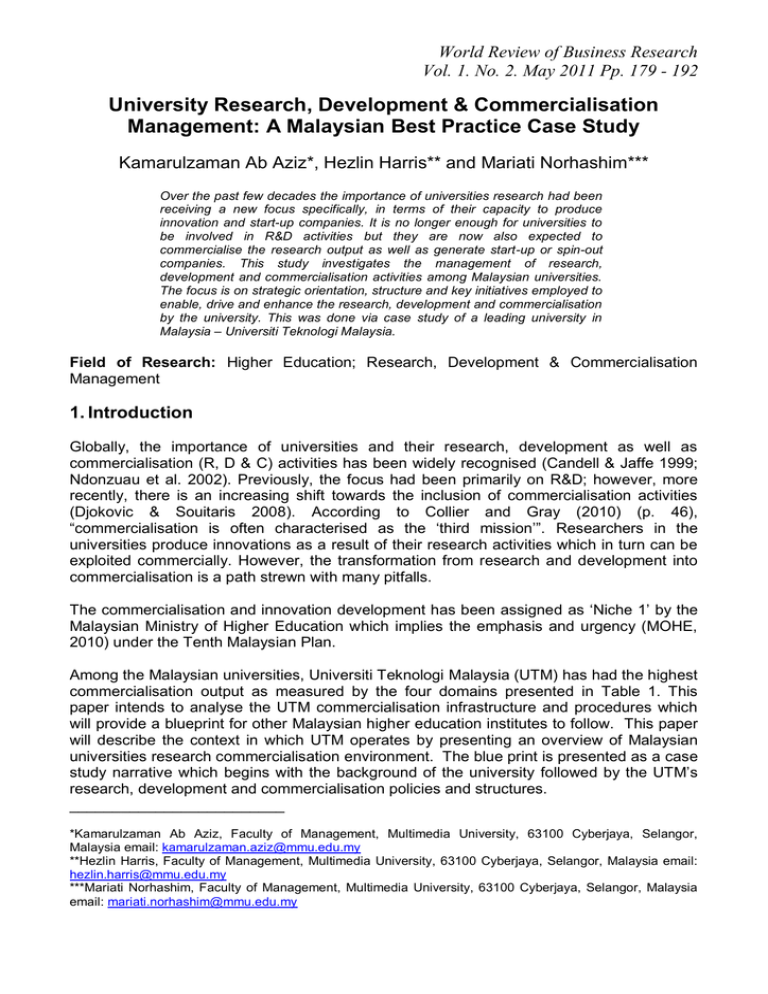
World Review of Business Research Vol. 1. No. 2. May 2011 Pp. 179 - 192 University Research, Development & Commercialisation Management: A Malaysian Best Practice Case Study Kamarulzaman Ab Aziz*, Hezlin Harris** and Mariati Norhashim*** Over the past few decades the importance of universities research had been receiving a new focus specifically, in terms of their capacity to produce innovation and start-up companies. It is no longer enough for universities to be involved in R&D activities but they are now also expected to commercialise the research output as well as generate start-up or spin-out companies. This study investigates the management of research, development and commercialisation activities among Malaysian universities. The focus is on strategic orientation, structure and key initiatives employed to enable, drive and enhance the research, development and commercialisation by the university. This was done via case study of a leading university in Malaysia – Universiti Teknologi Malaysia. Field of Research: Higher Education; Research, Development & Commercialisation Management 1. Introduction Globally, the importance of universities and their research, development as well as commercialisation (R, D & C) activities has been widely recognised (Candell & Jaffe 1999; Ndonzuau et al. 2002). Previously, the focus had been primarily on R&D; however, more recently, there is an increasing shift towards the inclusion of commercialisation activities (Djokovic & Souitaris 2008). According to Collier and Gray (2010) (p. 46), “commercialisation is often characterised as the „third mission‟”. Researchers in the universities produce innovations as a result of their research activities which in turn can be exploited commercially. However, the transformation from research and development into commercialisation is a path strewn with many pitfalls. The commercialisation and innovation development has been assigned as „Niche 1‟ by the Malaysian Ministry of Higher Education which implies the emphasis and urgency (MOHE, 2010) under the Tenth Malaysian Plan. Among the Malaysian universities, Universiti Teknologi Malaysia (UTM) has had the highest commercialisation output as measured by the four domains presented in Table 1. This paper intends to analyse the UTM commercialisation infrastructure and procedures which will provide a blueprint for other Malaysian higher education institutes to follow. This paper will describe the context in which UTM operates by presenting an overview of Malaysian universities research commercialisation environment. The blue print is presented as a case study narrative which begins with the background of the university followed by the UTM‟s research, development and commercialisation policies and structures. _________________________ *Kamarulzaman Ab Aziz, Faculty of Management, Multimedia University, 63100 Cyberjaya, Selangor, Malaysia email: kamarulzaman.aziz@mmu.edu.my **Hezlin Harris, Faculty of Management, Multimedia University, 63100 Cyberjaya, Selangor, Malaysia email: hezlin.harris@mmu.edu.my ***Mariati Norhashim, Faculty of Management, Multimedia University, 63100 Cyberjaya, Selangor, Malaysia email: mariati.norhashim@mmu.edu.my Aziz, Harris & Norhashim 2. Literature Review When commercialising university‟s researches, there are three main strategies commonly applied; patenting or licensing, contract research, and the creation of university spinouts (USOs) companies (Kroll & Liefner 2008). The importance of academic research can be seen through spin-off creation (Clayman & Holbrook 2004; Hindle & Yencken 2004). Not only that, the importance of university research has caught the attention of the industry players. They are now relying heavily on the university research results (Fabrizio 2006). Their observation seems to be supported by earlier studies carried out both in the UK and the US (UNICO 2001; AUTM 2002). USOs also had been identified as an effective vehicle for technology transfer (Roberts & Malone 1996) and as important tool for commercialisation for university research (Wright et. al. 2007). Furthermore, several studies indicate that the formation of USO companies is a more successful route to commercialisation than licensing (Gregory & Sheahe 1991; Bray & Lee 2000; Rogers, Takegami & Yin 2001). Breznitz, O‟Shea and Allen (2008) found that Masachusetts Institute of Technology‟s (MIT) success was partly due to access to regional infrastructure; meanwhile Yale University‟s success was due to the provision of infrastructure internally. A number of studies have identified several key initiatives implemented by universities towards enhancing their success rates in commercializing their research outputs and creating USOs. The initiatives include technology incubators, science and technology parks, subsidy programs, entrepreneurship centres, creating specialized offices – technology licensing office, commercialisation office, etc; incentive structures, royalty regimes, and equity investments (Mian 1997; Henrekson & Rosenberg 2001; Jensen & Thursby 2001; Feldman et al. 2002; Shane 2002, 2004; Siegel et al. 2003; Link & Scott 2005; Lockett & Wright 2005; Powers & McDougal 2005; Rasmussen et. al. 2006). A number of studies investigate the aspects of technology transfer and commercialisation by universities, such as studies by Reimers (1999), AUCC (2001), Tornatzky, et al. (2002), Lambert (2003), Miles and Daniels (2007), and Smilor and Matthews (2004). However, most of the studies come from developed nations. A developing country like Malaysia is still behind in terms of its research capabilities as evidenced by various rankings. In fact, Malaysia has just entered the commercialisation game very recently. This is evidenced by the fact that the Ministry of Higher Education‟s focus in terms of driving R&D activities among the universities had evolved from establishment of a research culture (2006 - 2008), to driving quality research (2008 – 2010), and most recently to promote research excellence through producing innovation and its commercialisation (2011 – 2012). The purpose of this study is to present a case study of an initiative to drive commercialisation from one of the premier Malaysian university. The university studied was awarded the highest number of intellectual property registered with MyIPO, the Malaysian Intellectual Property Office which handles the IP filing in Malaysia. 3. Methodology Using a case study approach, the top commercialisation producer among the Malaysian universities were selected, namely Universiti Teknologi Malaysia (UTM). The analysis reviews UTM‟s strategic orientation, structure and key initiatives employed to enable, drive and enhance the research, development and commercialisation by the university. A 180 Aziz, Harris & Norhashim narrative of the management of research, development and commercialisation activities in UTM offers the blueprint for an R&D&C management system for a higher education institution. The case-study methodology (Eisenhardt 1989; Yin 1994) was adopted and multiple sources of data were used. Specifically, the common types of case study sources of evidence as recognized by Stake (1995) and Yin (1994), namely; documents, archival records, interviews, direct observation, and participant observation. Yin also argued that the relative size of the sample whether 1, 10 or 100 cases does not determine the quality of the study. This paper begins with an overview of Malaysian Universities research commercialisation to provide the background of current achievements and resources available for driving research, development and commercialisation (R, D & C). The case study narrative begins with the background of the university. Next, we present the policy that has been put in place to provide the focus and strategy for driving R, D & C in UTM and the structure in place to support the R, D & C activities. Policy and structure however are not sufficient to ensure commercialisation success as UTM has recognized that the key ingredient is the human capital behind the entrepreneurial process. The case study ends with a look at a unique programme initiated by UTM to develop its entrepreneurial pool. 4. Malaysian Universities: An Overview The Ministry of Higher Education (MOHE) reported the research commercialisation achievement by the Malaysian public universities up till August 2008 (Table 1), which is the most current report available at the time of this study. According to the report, the 16 public universities in Malaysia had only managed to commercialise 58 products out of the 313 identified with commercial potential. The achievements among the private universities were found to be no better than what was seen from the public ones. It was clear that there is a need to address the situation and drive the universities to better performance levels. At the individual IHL/university level commonly the ecosystem for R&D and business creation would include the following: Infrastructure and infostructure for R&D activities (e.g.: library, databases, laboratories, equipment, etc.) Organizational structure o R&D Management (e.g.: Research Management Centre) o Commercialisation Management (e.g.: Business Unit, Commercialisation Centre, Technology Licensing Office (TLO), Innovation Centre, Technology Transfer Office (TTO), Training and Consulting Unit, Business Creation Office, Incubator, etc.) Human capital Policies (e.g.: R, D & C Roadmap, training and development programmes, incentives, KPIs, funding, etc.) 181 Aziz, Harris & Norhashim Table 1: University Research Commercialisation until August 2008 (Source: MOHE) Universities Universiti Teknologi Malaysia (UTM) Universiti Putra Malaysia (UPM) Universiti Kebangsaan Malaysia (UKM) Universiti Malaya (UM) Universiti Sains Malaysia (USM) Universiti Teknologi Mara (UiTM) Universiti Malaysia Pahang (UMP) Universiti Malaysia Sabah (UMS) Universiti Utara Malaysia (UUM) Universiti Tun Hussein Onn Malaysia (UTHM) Universiti Malaysia Sarawak (UNIMAS) Universiti Islam Antarabangsa Malaysia (UIAM) Universiti Pendidikan Sultan Idris (UPSI) Universiti Malaysia Terengganu (UMT) Universiti Malaysia Perlis (UniMAP) Universiti Teknikal Malaysia Melaka (UTEM) Total Total R&D with Potential for Commercialised Products 110 15 33 Total No. of IP 153 70 56 Patent 9 12 3 Trade mark 28 27 20 Total Commercialise d Products 6 16 0 0 11 5 0 0 0 0 11 4 22 0 0 0 0 3 15 8 1 0 0 3 31 9 0 29 26 21 16 45 39 35 30 26 21 19 0 8 0 4 12 0 2 2 4 8 0 0 0 8 8 0 0 2 4 6 0 0 0 0 2 0 3 0 5 0 40 122 58 313 533 There are a number of funds, grants and incentives made available by the government to enable innovation and business creation among the universities. Following Figure 1 shows some examples of the government initiatives. It was reported that under the 9th Malaysia Plan (2006 - 2010), the Malaysian government invested a total of RM3.101 billion in the form of R&D grants. Meanwhile, under the 10 th Malaysia Plan (2011 – 2015), the government allocated RM741 million for R&D among the universities for the first two years of the five years plan. The allocation was to be managed by the Ministry of Higher Education. In line with the new directives, the ministry announced a set of 4 R&D schemes to utilise the RM741 million allocations (See Table 2). There are three new aspects of the schemes, namely, the ERGS, LRGS and PRGS. Previously the Ministry only had one R&D grant scheme, the FRGS. The introduction of ERGS, LRGS and PRGS, reflects the government‟s desire to enhance the research, development and commercialisation activities among the universities. The three new schemes bridge the gap between university R&D activities and the programmes in placed to drive commercialisation and business creation. In terms of the development of commercialisation efforts in the Malaysian higher education sector, the trend had been; i) establishment of private universities, ii) establishment of consultancy centres, iii) emphasising research - identification of research agenda, creation of “Research University” and “Apex University” status for the public universities and the establishment of research management centres, and iv) emphasising research commercialisation – this was seen more from government agenda, e.g.: the RM 191.5 182 Aziz, Harris & Norhashim billion budget announced for 2010 with the aim to create an economy based on innovation, where university R, D & C is one of the key success factor. Figure 1: Government Financial Programmes Cradle Investment Programme (CIP) (www.cradle.com.my) Seed funding for turning technology oriented ideas into commercial ventures. The programme also include a sub-programme for university spin-outs and start-ups; University Cradle Investment Programme (U-CIP). Demonstrator Application Grant Scheme (DAGS) Manage by the Ministry of Science, Technology and Innovation (MOSTI). It is seed fund for ICT-based community pilot projects. eContent Fund Manage by MOSTI. Fund for content creation projects. InnoFund Manage by MOSTI. Fund for innovation commercialisation projects. Multimedia Super Corridor (MSC) Malaysia Intellectual Property (IP) Grant Scheme Manage by Multimedia Development Corporation (MDeC). The scheme provides subsidy up to 70% of IP protection costs. However, this is done in reimbursement basis and application should be made after the process had been done. MSC Malaysia R&D Grant Scheme (MGS) Manage by MDeC. The scheme provide grant for R&D activities conducted in Malaysia. eScience Fund Manage by MOSTI. The fund for R&D projects in priority areas largely targeted by universities. Techno Fund Manage by MOSTI. Fund for pre-commercialisation projects and IP acquisition. MSC Malaysia Technopreneur Pre-Seed Fund Programme Managed by MDeC till 2009. This was transferred to CIP and rebranded as CIP Catalyst pre-seed fund programme. The fund is for technopreneur start-up creations. Table 2: 10th Malaysia Plan Ministry of Higher Education R&D Schemes (Source: MOHE) No. Scheme Allocation (2011 – 2012) 1 Fundamental Research Grant Scheme (FRGS) 300 million 2 a. Exploratory Research Grant Scheme (ERGS) 300 million b. Long-Term Research Grant Scheme (LRGS) c. Prototype Research Grant Scheme (PRGS) 3 Research Incentive 41 million 4 MOHE Special Project 100 million TOTAL 741 million 5. Case Study: Insights from the South Universiti Teknologi Malaysia (UTM), with its main campus in Johor and a smaller campus in Kuala Lumpur, is one of the original research universities. It‟s one of the major universities in Malaysia, with 2000 academic staff, around 21000 undergraduate and 8000 183 Aziz, Harris & Norhashim postgraduate students. It has 14 faculties, 1 language academy, 5 schools for graduate studies, and 1 school for continuing education. Its history can be traced back to 1904 as the country‟s first technical school. The school evolved into a college, then an institute and on 1st April 1975 it was upgraded to Universiti Teknologi Malaysia. UTM‟s mission is to lead in the development of creative and innovative human capital and advanced technologies that will contribute to the nation‟s wealth creation. i) Strategic Orientation for Research, Development and Commercialisation It is clear (see Figure 2) that UTM has a strategic orientation for research, development and commercialisation that centred on an entrepreneurial mindset, collaborative efforts and engagement of parties beyond the university. This has led UTM to winning the National Intellectual Property Award of organization category, three times. Furthermore, UTM was the first university in Malaysia to establish a technology transfer company – Unitechnologies. UTM‟s research, development and commercialisation activities are guided by a number of policies, including IP Commercialisation Policy, Intellectual Property Policy, and Research & Development Policy. The IP Commercialisation Policy governs the ownership structure, revenue sharing and other rights and benefits pertaining to commercialised research outputs. The Intellectual Property Policy governs the IP management, filing processes and ownership policy of the IP. Research & Development Policy governs research project and grant management issues. Figure 2: UTM’s Strategic Orientation for Research, Development and Commercialisation (Source: http://www.icc.utm.my/en/services.html) These policies are intended to provide support, guidance and framework to enhance researchers‟ productivity. These policies are implemented through separate structures that are geared specifically towards research and development on one hand and 184 Aziz, Harris & Norhashim commercialisation on the other. They are however working synergistically as a UTM system has evolved and restructured over time to eliminate redundancies and inefficiencies. ii) The Structure to Drive Research and Development UTM‟s structure for research, development and commercialisation was arranged along the lines of research centres which specialises in a particular research area. Firstly, the eleven Research Alliances in sustainability, infocomm, water, cybernetics, biotech, construction, materials and manufacturing, k-economy, energy, transportation, and nanotechnology. Research Alliances are associations of centres of excellences, laboratories, professors and groups of researchers in UTM. The Research Alliances aim to conduct research (knowledge discovery, dissemination and commercialisation) in the respective multidisciplinary research areas. In other words, the structure allows sharing of resources. The sharing of resources however must be coordinated for efficiency and effectiveness. UTM also has 28 Centres of Excellences as shown in Figure 3. The overall management of research is carried out by the Research Management Centre (RMC), which also maintains a Directory of Researchers and List of R&D Products. Other than the above, UTM has a number of initiatives that further contribute towards enhancing the R&D. Following are a number of those key initiatives: Universiti Teknologi Malaysia Institutional Repository (UTM-IR) is a centralized digital archive managed by the university‟s library where research output of UTM researchers are collected and preserved. UTM-IR is UTM‟s open access initiative where the collection of scholarly materials by UTM‟s researchers are showcased and shared to further drive research in Malaysia. UTM Idea Bank is an interactive forum that allows the students, staff and UTM partners to submit innovative and creative ideas to the university. UTM‟s Technovation Park was officially launched in August 1995 and acquired Multimedia Super Corridor (MSC) status in December 2002. The park is registered with Association of University Related Research Parks (AURP) and National Business Incubation Association (NBIA). The Park was designed to provide a comprehensive framework for the development of technology enterprise especially in technology and biotech development. The emphasis is through smart partnership with industry partners, self-sustainable and benefiting UTM academician and student. The significance of the structure to drive R&D in UTM discussed above can be seen in the accumulated IPs as shown in Table 3. iii) The Structure to Drive Commercialisation Innovation and Commercialisation Centre (ICC) is UTM‟s one stop centre for technology innovation and commercialisation. ICC was set up in June 2010 to replace the Bureau of Innovation and Consultancy (BIC). This provides a clear focus on efforts to produce innovations and their commercialisation. The ICC works strategically with the faculties, research alliances, and centres of excellence in UTM to identify, develop and commercialise UTM‟s innovations. ICC is now responsible for Intellectual Property (IP) management and exploitation which were formerly under the jurisdiction of the Research 185 Aziz, Harris & Norhashim Management Centre (RMC). There are two sub-units in the ICC which are responsible for innovation and commercialisation aspects; namely, Innovation and Commercialisation. Figure 3: Centres of Excellences No. 1. 2. 3. 4. 5. 6. 7. 8. 9. 10. 11. 12. 13. 14. 15. 16. 17. 18. 19. 20. 21. 22. 23. 24. 25. 26. 27. 28. Centres Advanced Information Technology Institute (AITI) Automotive Development Centre (ADC) Advanced Photonic Science, Institute of (APSI) Centre for Artificial Intelligence and Robotics (CAIRO) Centre for Advance Software Engineering (CASE) Centre of Electrical Energy Systems (CEES) Centre for Technology Policy & International Studies (CENTEPIS) Centre for the Study of Built Environment in the Malay World (KALAM) Centre for Lipids Engineering Applied Research (CLEAR) Centre for Real Estate Studies (CRES) Chemical Engineering Pilot Plant (CEPP) Coastal and Offshore Engineering Institute (COEI) Composite Centre (CC) Construction Technology & Management Centre (CTMC) Ibnu Sina Institute for Fundamental Science Studies (IIS) Institutes of Environmental & Water Resource Management (IPASA) Institute for Geo-Spatial Science and Technology (INSTEG) Institute of High Voltage & High Current (IVAT) Gas Technology Centre (GASTEG) Marine Technology Centre (MTC) Wireless Communication Centre (WCC) Steel Technology Centre (STC) Photonics Technology Centre (PTC) Institute of Sultan Iskandar (ISI) Institute of Noise & Vibration (IKG) Centre of Rural Planning Studies (PKPLB) Advanced Information Technology Institute (AITI) Automotive Development Centre (ADC) Table 3: Accumulated IP until 5/1/2011 (Source: UTM) Category Total Patent Filing 234 Granted 15 Copyright 329 Industrial Design 3 Trademark 40 Utility Innovation 5 TOTAL 626 ICC – Innovation Unit: The Innovation Unit provides assistance to the UTM inventors, innovators and entrepreneurs by making their ideas more commercially successful through networking with industry and affiliate partners. Traditionally, the focus was centred at commercialisation only 186 Aziz, Harris & Norhashim but with the new structure, Innovation Unit is held responsible to encourage innovation among UTM lecturers as well as students. Innovation Point is one of the initiatives taken by the Unit. The Innovation Point takes care of the incubation and the Product Development Technology (PDTC). In order to accelerate the pursuit of innovation, the Innovation Point takes a more proactive initiative by meeting up with the faculty members and also Research Alliances (RA) to find out the types of research that the researchers are doing. ICC – Commercialisation Unit: The Commercialisation Unit involves in assisting the UTM inventors, innovators and entrepreneurs in the formation of spin-off start-ups, joint ventures and partnerships. The unit also conducts related trainings and courses such as financial planning for the entrepreneurs to equip them with knowledge on how to construct their business plans etc. Although the business plan can be outsourced to external parties, the unit views that it‟s pertinent that the entrepreneurs themselves explore and learn about the target market, market size and share and other industry players. A clear and comprehensive approach to IP management is also in place. The Unit is in charge of recording disclosure forms for researchers who would like to voluntarily disclose their inventions. The Unit then seeks assistance from the external parties such as the patent agents to do patent search. The patent agent will advise the Unit to proceed for the patent application if the invention is found to be novel. Subsequently, the invention will undergo a series of evaluation from both internal and external committees. There are two evaluation phases within the internal committee; 1) the Commercialisation Unit which consists of ICC members and 2) the representatives from the Research Alliances (RA) who are related to the field of technology. The next stage includes evaluation from the external parties such as SME Corporation, MTDC, investment bankers and industry partners. The internal committee which consists of RA must have a minimum number of 7 members including one chairman. The process of evaluation begins by obtaining the number of IP targets for half of the year. Then based on the evaluation, the number is usually reduced. Feedbacks from the external parties are taken into consideration whether the IP should be obtained or shouldn‟t be obtained. If the invention does not receive favourable feedback from the external parties, it is returned to the inventor for further improvement in terms of value-added or design wise. With the establishment of ICC within the new structure, UTM aspires to increase not only the number of IP exploitation but also innovation. The shift of emphasis to innovation is taken in light of the disparity in the market demand in the Asia and Western. In Asia, the industry players are only interested in readymade products. From creation to exploitation – the Innocom: Currently, ICC relies heavily on the patent agents to do patent search. However, ICC aims to educate UTM inventors to do own patent search, market search etc. through a series of related courses. The inventors are also expected to think one step ahead in the design and explore the commercial aspects of their inventions. These actions are employed to transform the mindset of the inventors where traditionally, the inventions were purely created out of curiosity or through journals. The shift of dependence from the external agents is also seen in the establishment of scoring system known as Innocom. This evaluation process is taken place within the RA. The implementation of the Innocom scoring system is also part of the aggressive move 187 Aziz, Harris & Norhashim towards IP exploitation. Upon obtaining the scoring point, the inventors will attach the scoring form together with the disclosure form and submit it to the ICC. According to the scoring system, each invention is evaluated and rated based on the following areas; commercial potential, competitors, local or global market value, target market and importantly, motivation of the inventors. A threshold of 50 points is required for inventions that have the potential to be patented. The motivation of the inventors will determine whether a company should be formed or proceed with joint venture or simply license the invention to existing company. The inventors are proposed to form a company if the score points are as high as 80%. The inventors are considered risk averse if the score points are between 70% - 80%. If this is the case, inventors are suggested to license out or joint venture. In the company formation, inventors can only be one of the board of directors not the managing director. They, however, are given a share in the company. The ICC‟s workflow is shown in Figure 4: Figure 4: ICC’s Workflow (Source: http://www.icc.utm.my/en/corporate-info.html) The emphasis on scoring was a result of the concern that prior focus on IP filing without similar emphasis on commercialisation was backfiring. The cost of filing IP can come up to thousands of dollars with further thousands for maintaining the rights. These investments more often than not in the past have been in vain as no commercialisation resulted from the patents. The scoring is intended to ensure commercial viability of the product is tested before proceeding for filing for IP and subsequently pushed towards commercialisation. 188 Aziz, Harris & Norhashim Another roadblock to transforming patents to commercialisation is the disinterest or incapability of the researcher to become an entrepreneur. Thus, a method was needed to be developed to build a pool of entrepreneurial talent which can bring the product to market. iv) Ensuring Success The first three sections highlighted UTM‟s orientation and structure designed to drive the research, development and commercialisation efforts in the university. These are then completed with an effort designed to ensure success and follow through. The management realised that in order to achieve success in commercialisation of the university‟s innovation, they needed a pool of entrepreneurs to lead the efforts. It was found that researchers often lack the skills and sometimes desire to commercialise their research, thus, the creation of the UTM-MTDC Symbiosis Programme. UTM-MTDC Symbiosis Programme, is an entrepreneur development programme targeting top UTM graduates. It is a collaborative effort between UTM with Malaysian Technology Development Corporation (MTDC), where UTM is the technology supplier and MTDC is the financier as well as business coach. The programme has 5 phases: 1. 2. 3. 4. 5. Induction Course Entrepreneurship Course IC2 Technology Commercialisation Course Incubator Programme Graduation The programme starts by identifying 30 top graduates to undergo phase 1-3. The selected graduates are required to go through several tests including entrepreneurial mindset. These potential entrepreneurs are exposed to a series of related trainings, courses and coaching such as developing business plan. Then, 10 are selected to progress to phase 4, which is a 24 months incubation where the entrepreneurs establish their businesses with the financial support from MTDC. The entrepreneurs become the CEO of their businesses while the ownership belongs to UTM. In addition to that, UTM licenses exclusively to the company and the company is allowed to license it to another company. UTM profits based on the four spin-off modes as depicted in Figure 4. The profits from such dividends or capital gains will be in turn ploughed back into the university‟s R, D & C efforts. It is hoped that the national agenda of turning universities into self-sufficient entities will be realised by the success of commercialisation of university R&D. 5. Conclusion Universities have been identified as one of the key factors for the growth and development of a nation. This is reflected in the vast amount of investment of public funds into research activities among the universities by the government. This is actually a global trend that can be seen among both developed and developing countries across the globe. The investments made are in expectation of benefits that can be reaped by the researchers as well as enriching the growth of the country's economy. This is definitely true for Malaysia. However, the trend had been that only small percentages of the R&D output by the universities in Malaysia do get commercialised. 189 Aziz, Harris & Norhashim This case study provides a blueprint for managing the R, D & C in a university. A blueprint however only provides a guideline. The implementation of the policies and the management of the processes require an understanding of the cost versus benefit considerations. It is impossible and impractical for a university to go it alone. The engagement of industry and government in making the system a success is crucial. References AUCC (Association of Universities and Colleges of Canada) 2001, Commercialization of University Research, viewed 10 January 2008, <http://www.aucc.ca/_pdf/english/reports/2001/commerc_05_25_e.pdf>. AUTM (Association of University Technology Managers) 2002, AUTM Licensing Survey. Northbrook, Ill: AUTM. Bray, MJ & Lee, JN 2000, „University revenues from technology transfer: Licensing fees vs. equity positions‟, Journal of Business Venturing, vol. 15, no. 5–6, pp. 385–392. Breznitz, SM, O‟Shea, RP & Allen, TJ 2008, „University Commercialization Strategies in the Development of Regional Bioclusters‟, Journal of Product Innovation Management, vol. 25, pp. 129-142. Candell, A & Jaffe, AB 1999, The regional economic impact of public research funding: a case study of Massachusetts, In L. M. Branscomb, F. Kodama & R. Florida. Industrializing Knowledge. US, MIT press: 510-530. Clayman, BP & Holbrook, JAD 2004, The Survival of University Spin-offs as a Measure of Research Funding Effectiveness, CPROST Report 04-03, viewed 10 January 2010, <http://www2.sfu.ca/cprost/docs/CFI%20spinoffs%20March2.doc>. Collier, A & Gray, B 2010, The commercialisation of university innovations – A qualitative analysis of the New Zealand situation, Research Report, viewed 24 April 2010, <http://www.otago.ac.nz/entrepreneurship/docs/Qual%20report_31%20August%202 010.pdf>. Djokovic, D & Souitaris, V 2008. „Spinouts from academic institutions: a literature review with suggestions for further research‟, Journal of Technology Transfer, vol. 33, pp. 225-247. Eisenhardt, KM 1989, „Building Theories from Case Study Research‟, Academy of Management Review, vol. 14, pp. 532-550. Fabrizio, K 2006. „The use of university research in firm innovation‟, In: ChesbroughH, VanhaverbekeW, WestJ (eds), Open innovation; researching a new paradigm, Oxford University Press, London. Feldman, M, Feller, I, Bercovitz, J & Burton, R 2002, „Equity and the technology transfer strategies of American research Universities‟, Management Science, vol. 48, no. 1, pp. 105-121. Gregory, WD & Sheahen, TP 1991, „Technology transfer by spin-off companies versus licensing‟, In Brett, A; Gibson, DV and Smilor, RW (eds), University spin-off companies, USA, Rowman & Littlefield Publishers, Inc, pp. 133-152. Henrekson, M & Rosenberg, N 2001, Designing efficient institution for science-based entrepreneurship: Lesson from the US and Sweden, Journal of Technology Transfer, vol. 26, no.3, pp. 207-231. Hindle, K & Yencken, J 2004, „Public research commercialisation, entrepreneurship and new technology based firms: an integrated model‟, Technovation, vol. 24, no. 10, pp. 793–803. Jensen, R & Thursby, M 2001, „Proofs and prototypes for sale: The tale of university licensing‟, American Economic Review, vol. 91, no.1, pp. 240-259. 190 Aziz, Harris & Norhashim Kroll, H & Liefner, I 2008, „Spin-off enterprises as a means of technology commercialization in a transforming economy – Evidence from three universities in China‟, Technovation, vol. 28, pp. 298-313. Lambert, R 2003, Lambert Review of Business-University Collaboration, HMSO, viewed 20 April 2010, <http://www.eua.be/eua/jsp/en/upload/lambert_review_final_450.1151581102387.pdf >. Link, AN & Scott, JT 2005, „Opening the Ivory Tower‟s Door: An analysis of the determinants of the formation of U.S university spin-off companies‟, Research Policy, vol. 34, no. 7, pp. 1106-1112. Lockett, A & Wright, M 2005, „Resources, capabilities, risk capital and the creation of university spin-out companies‟, Research Policy, vol. 34, no. 7, pp. 1043-1057. Mian, SA 1997, „Assessing and managing the university technology incubator: An integrative framework‟, Journal of Business Venturing, vol. 12, no. 4, pp. 251-285. Miles, N & Daniels, R, 2007, The State of the Innovation Economy in the UK-2007: Problems, Opportunities and Solutions, viewed 20 April 2011, <http://o2c.elektomi.net/controversy-corner/State%20of%20InnovEco.pdf> MOHE (Ministry of Higher Education) 2010, Niche 1: commercialisation and innovation development, AKEPT (Higher Education Leadership Academy) Centre For Leadership Research and Innovation, Putrajaya, viewed 18 April 2010, <http://www.mohe.gov.my/akept/doc/ACLRI/Niche_1.pdf>. Powers, JB & McDougall, PP 2005, „University start-up formation and technology licensing with firms that go public: A resource-based view of academic entrepreneurship‟, Journal of Business Venturing, vol. 20, no. 3, pp. 291-311. Rasmussen, E, Moen, Ø, Gulbrandsen, M 2006, „Initiatives to promote commercialization of university knowledge‟, Technovation, vol. 26, no. 4, pp. 518–533. Reimers, N 1999, Best North American Practices in Technology Transfer, Report to Expert Panel on the Commercialization of University Research of the Prime Minister‟s Advisory Council on Science and Technology, ACST, viewed 20 March 2002, <http://www.acst-ccst.gca.ca>. Roberts, EB & Malone, D E 1996, „Policies and structures for spinning off new companies from research and development organizations‟, R & D Management, vol. 26, no. 1, pp. 17-48. Rogers, EM, Takegami, S, Yin, J 2001, „Lessons learned about technology transfer‟, Technovation, vol. 21, no. 4, pp. 253-261. Shane, S 2002, „University technology transfer to entrepreneurial companies‟, Journal of Business Venturing, vol. 17, no. 6, pp. 537-552. Shane, S 2004, Academic Entrepreneurship: University Spin-offs and Wealth Creation. Edward Elgar, Cheltenham, UK/Northampton, MA, USA. Siegel, DS, Waldman, D & Link, AN 2003, „Assessing the impact of organizational practices on the productivity of University Technology Transfer Offices: An exploratory study‟, Research Policy, vol. 32, no. 1, pp. 27-48. Smilor, R & Matthews, J 2004, „University venturing: technology transfer and commercialisation in higher education‟, International Journal of technology Transfer & Commercialisation, vol. 3, no. 1, pp. 111-128. Stake, R 1995, The art of case research, Sage Publications, Thousand Oaks. Tornatzky, L, Waugaman, P & Gray, D 2002, Innovation U.: New University Roles in a Knowledge Economy, Southern Growth Policies Board, ISBN 0-927364-25-5. UNICO (The University Companies Association) 2001, Annual Survey on University Technology Transfer Activities, NUBS. 191 Aziz, Harris & Norhashim Wright, MB; Clarysse, P; Mustar & Lockett, A 2007, „Academic Entrepreneurship in Europe’, Edward Elgar, Cheltenham. Yin, R 1994, Case Study Research: Design and Methods, 2nd. Ed, Sage Publishing, Beverly Hills. 192

